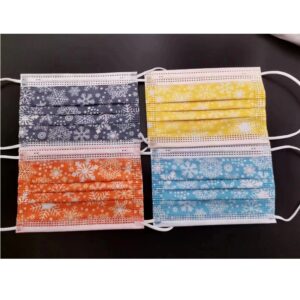Printed nonwoven fabric is a type of nonwoven fabric that has been printed with a design or pattern. Nonwoven fabric is a synthetic material made from finely spun fibers that are bonded together through heat, chemicals, or pressure. This type of fabric is lightweight, durable, and water-resistant, making it a popular choice for a wide range of applications, including printing.
Printing on nonwoven fabric is done using various techniques, such as screen printing, digital printing, or heat transfer printing.
Promotional items: Printed nonwoven fabric is often used in the production of promotional items, such as tote bags, backpacks, and drawstring bags. The printing process allows for the inclusion of logos, slogans, and other branding elements.
Home décor: Printed nonwoven fabric can be used to make curtains, tablecloths, and other home décor items. The printing process allows for the creation of unique designs and patterns that can be customized to match any décor.
Apparel: Printed nonwoven fabric can be used in the production of clothing items, such as jackets, vests, and hats. The printing process allows for the creation of custom designs and patterns that can be used to create unique and eye-catching apparel.
Medical and hygiene products: Printed nonwoven fabric can be used in the production of medical and hygiene products, such as surgical gowns, face masks, and wet wipes. The printing process allows for the inclusion of instructions, branding, and other information on the fabric.
Some benefits of printed nonwoven fabric include:
Customization: Printed nonwoven fabric allows for the creation of custom designs and patterns, making it a versatile and flexible option for a wide range of applications.
Durability: Nonwoven fabric is durable and can withstand regular use and washing, making it a long-lasting option for many applications.
Water resistance: Nonwoven fabric is water-resistant, which helps to protect the contents of bags or other items made from the fabric from moisture.
Cost-effective: Printed nonwoven fabric is printed nonwoven fabric supplier often more cost-effective than other printed fabrics, making it a popular choice for promotional items and other applications.
Overall, printed nonwoven fabric is a versatile and practical option for a wide range of applications, offering customization options, durability, and cost-effectiveness.
What are some other benefits of using nonwoven fabric?
Nonwoven fabric is a versatile material that offers many benefits for a wide range of applications.
Here are some additional benefits of using nonwoven fabric:
Lightweight: Nonwoven fabric is lightweight and easy to handle, making it a popular choice for applications where weight is a concern, such as in aerospace or automotive industries.
Breathable: Some types of nonwoven fabric are breathable, allowing air to pass through the material. This makes it a popular choice for applications such as medical textiles and hygiene products.
Versatile: Nonwoven fabric can be customized to have a variety of properties, such as stiffness, softness, and water resistance, making it suitable for a wide range of applications.
Durable: Nonwoven fabric is durable and can withstand regular use and washing, making it a long-lasting option for many applications.
Cost-effective: Nonwoven fabric is often more cost-effective than other types of fabrics, such as woven fabrics, due to its efficient manufacturing process.
Eco-friendly: Some types of nonwoven fabric are made from recycled materials, making them an environmentally friendly option. Additionally, nonwoven fabric can be recycled after use, reducing waste.
Hygienic: Nonwoven fabric is often used in medical and hygiene applications due to its ability to be sterilized and its resistance to bacteria and mold growth.
Overall, nonwoven fabric is a versatile and practical material that offers many benefits for a wide range of applications. Its lightweight, breathable, and durable properties, along with its cost-effectiveness and eco-friendliness, make it a popular choice for many industries.
